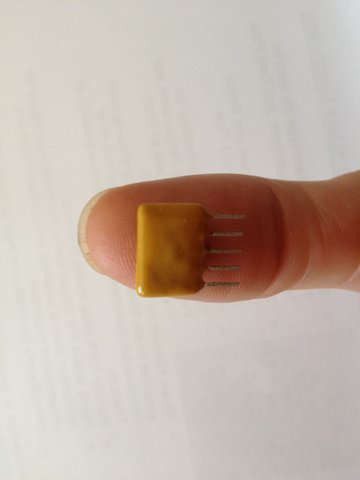Upgraded PCB design
Monday, 08 April, 2013
Can your printed circuit board (PCB) operate in a liquid? Is your PCB secure against reverse engineering? Do you want your PCB to be smaller? Do you want better performance from your PCB? Hybrid Electronics Australia manufactures thick film hybrid (Hybrid) electronic circuits which can replace PCBs, be integrated with PCBs or upgrade PCBs.
A thick film hybrid (hybrid) is an alternative to a printed circuit board (PCB). It is generally smaller, claimed to be competitively priced, gives intellectual property protection by being fully encapsulated and is more robust than a PCB. A hybrid can work underwater, buried in sand and in extreme heat. In most cases a PCB cannot.

What is a thick film hybrid (hybrid)?
A hybrid is a combination of semiconductor and ceramic (or metal) technologies.
Resistors on PCBs are mounted, whereas on hybrids they are printed, fired and laser trimmed to any value. A hybrid can be more precise and smaller in size than a PCB.
How is it made?
Hybrids are made using screen printing processes with stainless steel screens and firing the printed and dried inks into the surface of the ceramic or dielectric coated metal substrate. This firing process is generally at 850°C ±1° for resistor firing.
Why use hybrids rather than PCBs?
Smaller size: Resistors are printed, fired and laser trimmed and can be smaller than soldered chip resistors (that are the same technology). Generally, the space saving is at least 50% of PCB board area.

Higher accuracy:
- Resistors can be laser trimmed to closer tolerances.
- Resistors can be ratio trimmed with other resistors.
- Resistors can be ‘active trimmed’ to calibrate the function of a circuit running during the trimming process or to match the tolerance values of capacitors.
- Resistors are more stable as hybrid electronics uses inks generally capable of ±50 ppm/°C compared with chip resistors of 200 or 300 ppm/°C.
- Resistor values can be fractional ohms to gigohms without leakage problems or thermal problems causing instability or noise.
Higher reliability: The ‘fired’ connections of resistors, tracks and dielectrics are claimed to be more reliable than the soldered and plated through connections of PCBs.
Higher security: Hybrid circuits are usually encapsulated in epoxies that are very difficult to remove without damaging the circuitry. This provides added security of intellectual property that is necessary in this day of ‘reverse engineering’.
Questions frequently asked:
What about EMC?
Ceramic substrates (with an earth plane on the back) are more resistant to EMC issues than PCBs due to the high dielectric constant of the ceramic ~8.5. Also, metal substrates can have the metal grounded and, of course, isolated with a dielectric layer from the multilayer circuitry on the higher layers.
What about cost?
Hybrids manufactured at Hybrid Electronics are claimed to be cost competitive with PCBs. The company has developed a 100% plate microprocessor programming and testing robotic technology that programs and tests assembled multicomponent plates. This is claimed to give it an ‘edge’ over PCB assembled circuits.
What about high frequencies?
Hybrid Electronics has made 1 gigahertz antenna amplifiers using printed inductors, capacitors and resistors that had a flat response as well as what is claimed as the lowest noise figure on the market.
Is the company quality certified?
Hybrid Electronics Australia is quality certified and complies with the requirements for ISO 9001:2008. Technologies of hybrids at Hybrid Electronics include:
- Stable thick film thermistor ink used for temperature measurement and fluid flow measurement.
- Two-thermistor element and single-thermistor element fluid flow technologies.
- Patented thick film technology on titanium used for fluid temperature and flow measurement as well as fluid pressure measurement.
- Strain element on titanium technology allowing more sensitive strain sensing measurements and fluid pressure measurements due to the relative flexibility of titanium.
- Robotic 100% plate testing of circuits.
Feeling the future: wearable tech simulates realistic touch
Researchers from Northwestern University have developed a device that applies dynamic forces in...
Enhancing stability in bioelectronic materials for computing
Scientists from Rice University have streamlined the production of a material widely used in...
How AI is remodelling the IoT
Incorporating AI into the IoT will dramatically enhance its capability and flexibility. But...





